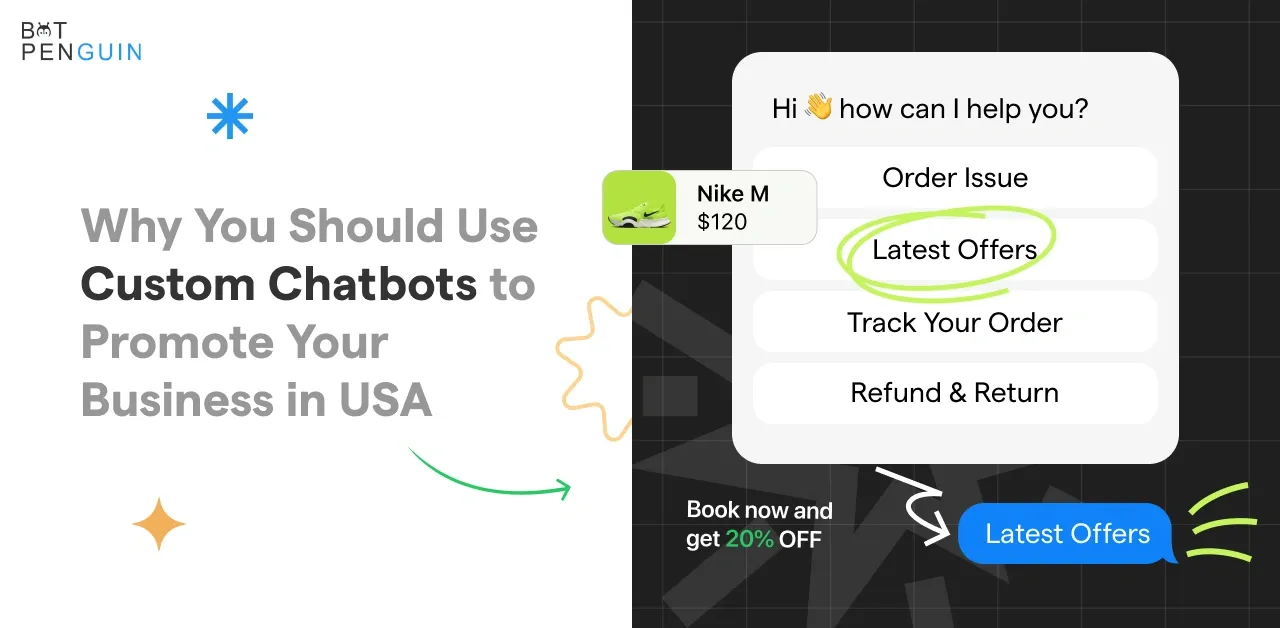To train ChatGPT on custom data effectively, you'll need a focused approach that ensures your custom AI chatbot aligns precisely with your operational requirements.
Training ChatGPT on custom data is an empowering step towards achieving a tailored conversational agent that understands and responds based on specific datasets relevant to your needs.
This process involves preparing and fine-tuning ChatGPT with unique data that represents the particular context or industry for which the chatbot is intended.
By doing so, you ensure that the model not only grasps the nuances of the required domain but also delivers responses that are significantly more accurate and contextually appropriate.
In this guide, I’ll explore the basics steps, and best practices on how to train ChatGPT on your own data.
How to Train ChatGPT on Your Own Data
Follow these simple steps to train ChatGPT on the custom data of your business and deploy an intelligent & helpful custom AI chatbot:
Step 1
Determine Chatbot Use Cases and Required Knowledge
The first step on how to train ChatGPT on custom data involves identify the specific use cases and workflows for deploying your custom AI chatbot. You may want a custom knowledge base chatbot to help your website visitors or a custom chatbot for internal business communication.
Whatever the need may be, you need to clearly define it because all other steps depend upon it. Consider this: Purpose, Placement, and Platform.
Step 2
Compile Relevant Training Data
Next, gather all the data relevant to training the chatbot according to the defined use cases. Before you train ChatGPT on custom data, make sure you have the high-quality data available for high-value automations.
This includes documents like help center articles, product catalogs, FAQs, customer conversation logs, manuals, and other domain-specific resources. Ensure the data is accurate, high-quality, and covers the breadth of information needed.
Step 3
Prepare the Dataset
As a rule, you should train chatGPT on custom data that is raw and improperly formatted. The unstructured data must be formatted into a training dataset for ChatGPT.
This involves cleaning the data, extracting key text portions, labeling different types of information, and structuring it for the model. The data may need to be aggregated from multiple sources and normalized into a consumable format.
Step 4
Train a Chatgpt Model
Here’s how to train a ChatGPT model:
- Fine-tune the model using your cleaned, industry-specific dataset for accuracy.
- Regularly test the model with sample queries to assess performance improvements.
- Adjust training parameters based on testing feedback to optimize outcomes.
- Integrate the trained model into your business’s existing digital platforms.
- Continuously update the data and retrain to maintain relevance and accuracy.
- Monitor user interactions to gather feedback and further refine the model.
When you train ChatGPT on custom data by following the right steps, your custom AI chatbot enhances business interactions and boosts overall customer satisfaction.
Suggested Reading:
ChatGPT Clone: How to Copy the GPT Model for Custom Chatbots
Step 5
Test and refine the model
Your ChatGPT model is only half-training at this point. The Custom AI chatbot needs rigorous testing to identify gaps. Testing across different query variations assesses strengths and weaknesses. The training process is then refined to expand the coverage of edge cases by generating more samples targeting the gaps.
Step 6
Integrate with Business Systems
Finally, the custom AI chatbot is integrated with business systems like CRM, ticketing tools, or website chat to deploy the chatbot into workflows. Governance controls are implemented to ensure transparency and monitor performance post-launch.
Step 7
Maintain through Continuous Feedback
As the custom AI chatbot evolves, new training data is fed back into the ChatGPT model to improve accuracy further. User feedback helps expand the knowledge base and training loops. Maintenance is key to a robust chatbot.
So these are the seven simple steps on how to train ChatGPT on custom data, designed to inform you the training framework you need.
Custom AI Chatbots: Best Practices To Train ChatGPT on Custom Data
Training your custom chatbot properly is key to providing accurate and helpful responses to customer inquiries. Here are some best practices on how to train a ChatGPT model for an effective Chatbot:
- Provide Diverse and Relevant Data: Train ChatGPT on custom data that contains diverse questions, including common and uncommon ones, along with their respective answers. This helps ensure your chatbot can respond accurately to various queries and scenarios.
- Keep Your Database Up-to-Date: As your business evolves, keep your database up-to-date to reflect any new products, services, or changes in customer behavior or preferences.
- Use Consistent and Clear Language: Use consistent and clear language in your database to avoid confusion and misinterpretation. Avoid using difficult or ambiguous language, and use simple, everyday terms.
- Incorporate User Feedback: Monitor the interactions between your custom chatbot and customers regularly and incorporate feedback from users to make necessary adjustments and improvements.
- Use Test Data to Evaluate Performance: Use test data to evaluate the performance of your custom chatbot during the training process. This helps identify gaps or errors in the chatbot's response generation and improves accuracy.
Training ChatGPT on Custom Data with a Chatbot Platform: The Custom Approach
Deploying a chatbot that meets specific business requirements can significantly enhance customer interaction. This detailed guide covers how to train ChatGPT on custom data using BotPenguin's versatile platform.
The Custom Approach
- Hire a Skilled Chatbot Developer: The first step in how to train ChatGPT involves engaging a developer proficient in Python, Java, and Node.js. Their expertise in creating NLP-based applications ensures a robust foundation for integrating conversational AI models like ChatGPT.
- Integration of Large Language Models (LLMs): For a chatbot that converses naturally, integrate LLMs such as GPT, Claude, and PaLM. This step is crucial for enhancing the chatbot’s ability to understand and generate responses that mimic human interaction.
- Fine-tuning the Language Model: Tailoring the language model to your industry’s specific terminology and client interactions is a vital part of how to train ChatGPT. This customization ensures the chatbot addresses user inquiries with precision.
- Testing and Debugging Language Models: Rigorous testing and debugging are imperative for refining the chatbot’s accuracy and handling capabilities. This ensures your AI consistently delivers high-quality interactions.
- Upgrades, Ongoing Maintenance, and Training: Continual updates and training on new datasets keep your chatbot at the cutting edge of AI advancements, ensuring ongoing relevance and effectiveness in user engagements.
Through these steps, businesses can effectively train ChatGPT on custom data, creating a chatbot tailored to unique interaction requirements and significantly enhancing customer service processes.
Check out why you should opt for BotPenguin's Custom Chatbot Development Services to build a ChatGPT integrated chatbot that is trained on your business data!
Training Your AI Chatbot Using BotPenguin: The Off-The-Shelf Approach
BotPenguin provides a streamlined, no-code solution for businesses looking for a quick deployment that still offers customization through training on existing data.
The Off-The-Shelf Approach
- Sign up for BotPenguin: Create an account to access the platform, which will set the stage for a straightforward chatbot development process.
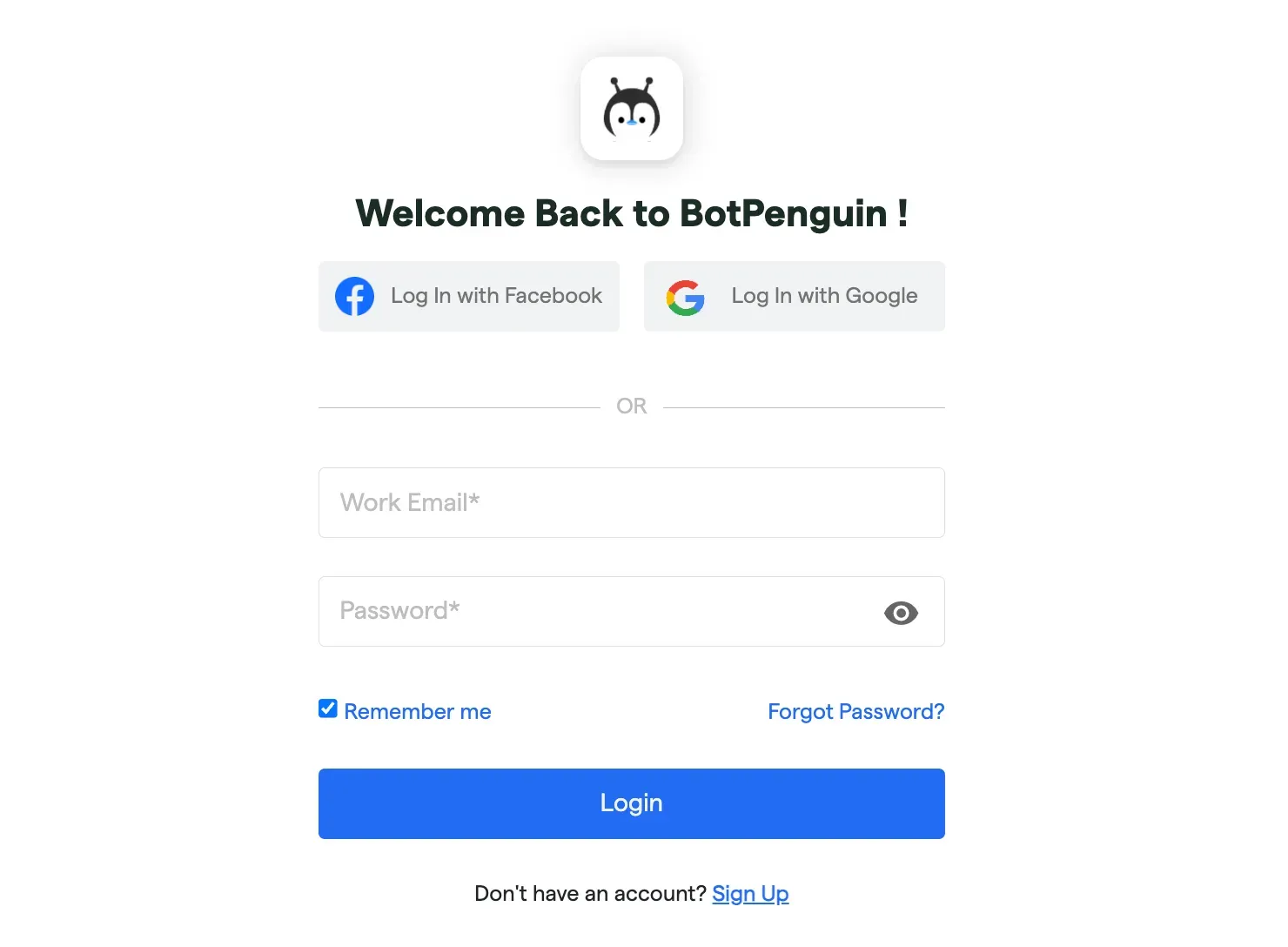
- Create a Bot: Use the dashboard’s "Create a bot" button to start the bot creation process, tailored to your chosen platform.
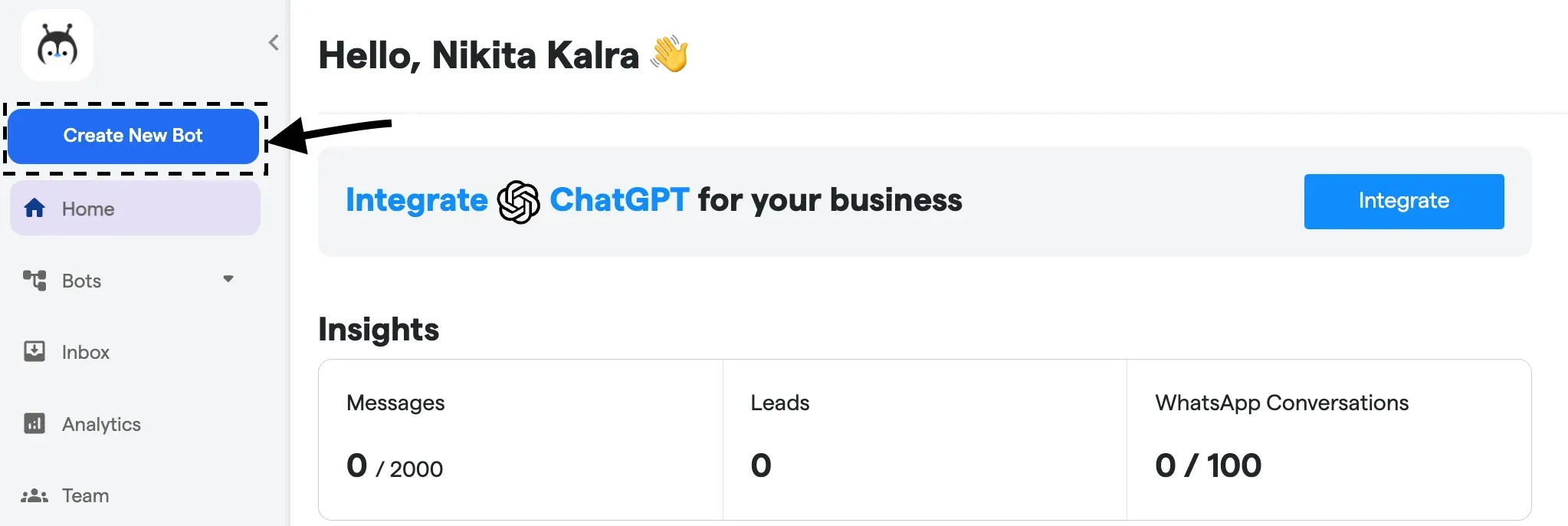
- Follow the On-Screen Instructions: Adhere to the guided steps specific to your platform to ensure optimal setup and functionality.
- Third-Party App Integration: After creation, integrate your chatbot with third-party applications such as ChatGPT via the dashboard.
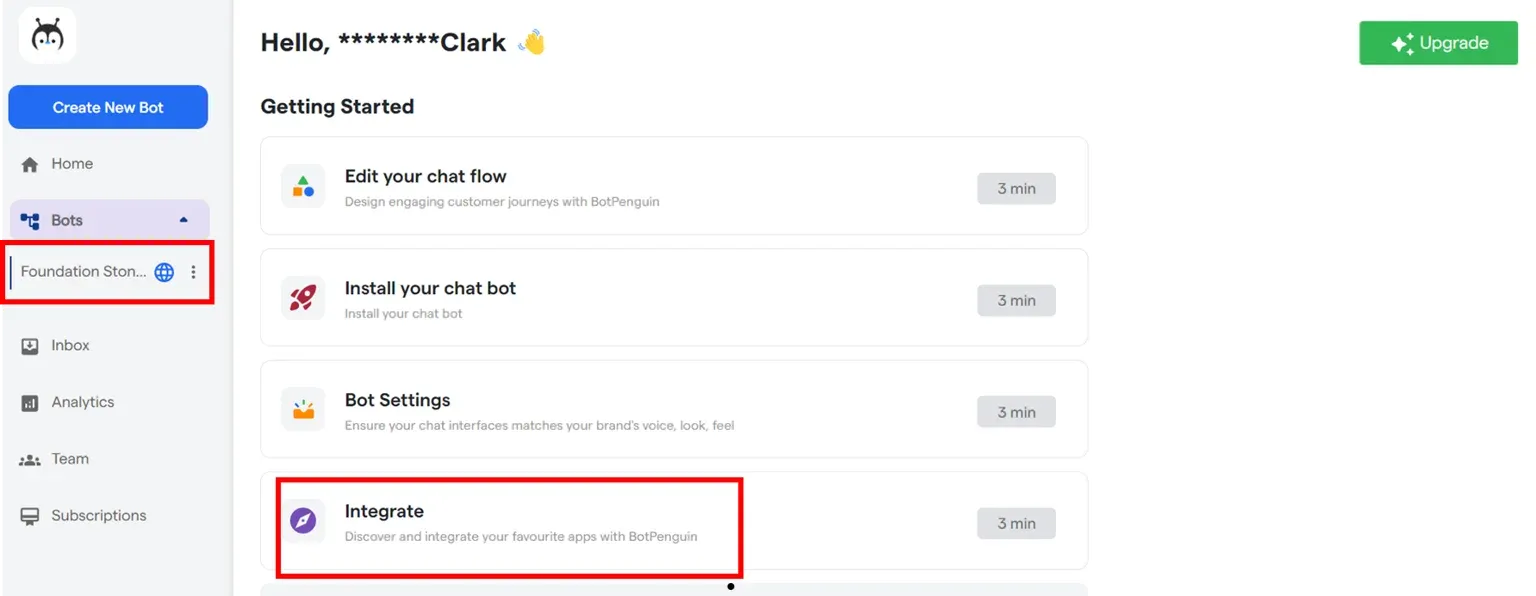
- ChatGPT Integration: Implement your OpenAI API key, choose the GPT model, and set up the knowledge base, starting with 100 free operations.
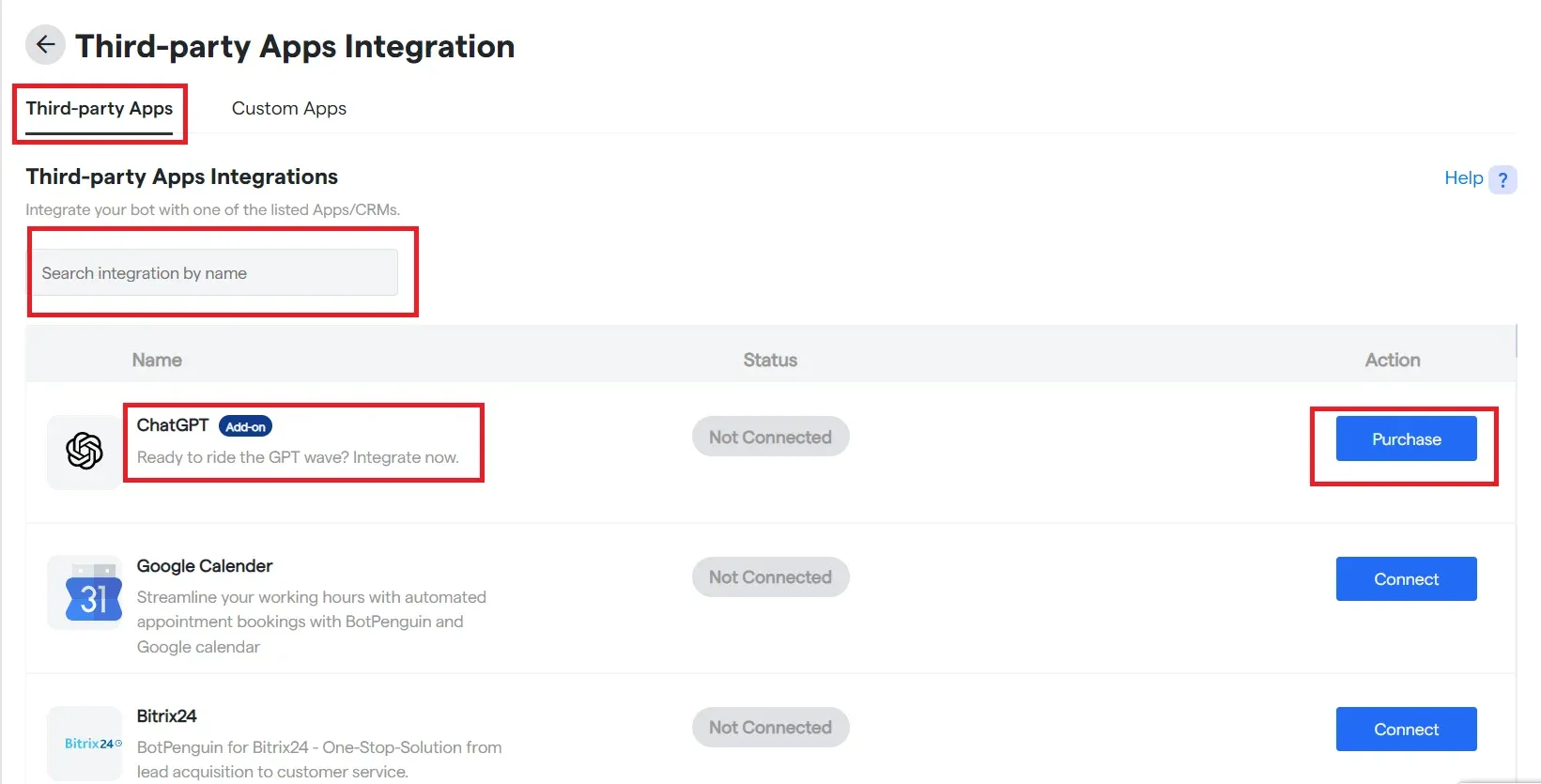
- Training on Custom Data: How to train your chatbot on your own data begins here.
- Integrate any ChatGPT model: Easily integrate any ChatGPT model to begin training.
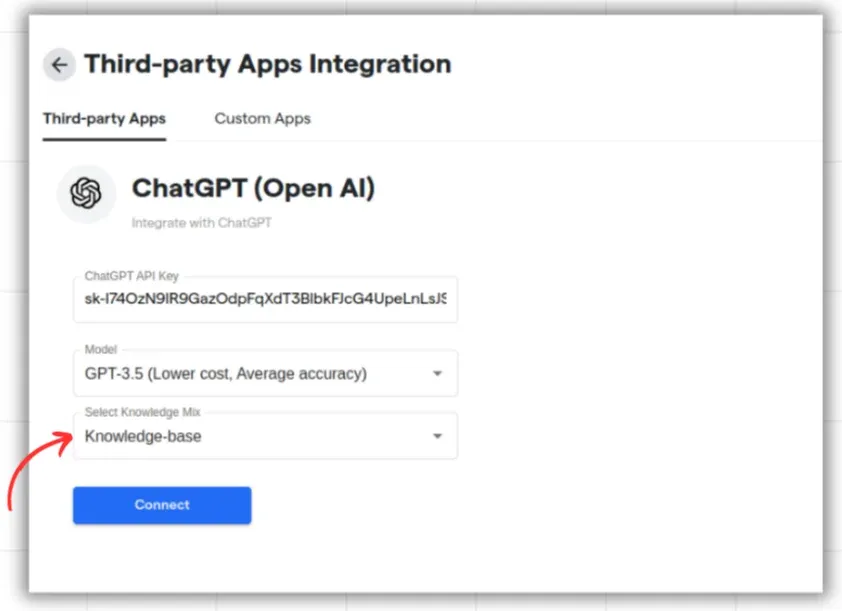
- Scrape URLs for training data: Automatically gather relevant data from specified websites.
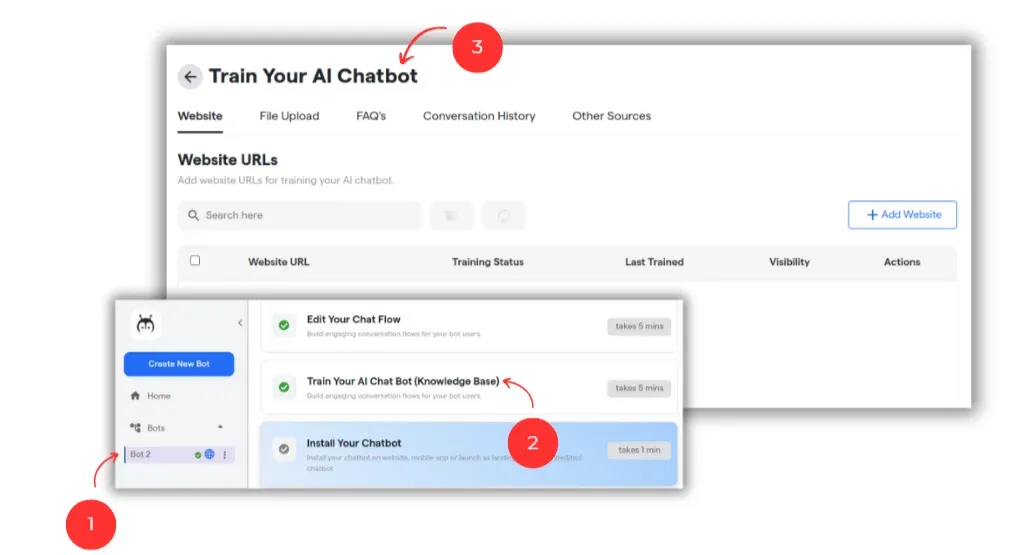
- Fetch data from Google Sheets: Integrate with Google Sheets and fetch data from there.
- Support multiple data formats: Add custom datasets in docx, docs, xls, pdf, etc.
- Incorporate FAQs directly: Manually add FAQs or through files to train ChatGPT.
- Use previous chatbot responses: Use previous responses of custom AI chatbots for training.
- Choose from 60+ Integrations: Expand your chatbot’s capabilities with a variety of integrations that include CRM systems and productivity tools.
- Testing and Deployment: Thorough testing is essential before going live to ensure your chatbot functions seamlessly in real-world scenarios.
Following these steps, you can effectively train ChatGPT on custom data, enhancing its relevance and accuracy.
Investing in a robust chatbot maker and integration platform is essential for leveraging ChatGPT's full capabilities. Such platforms facilitate seamless integration with various data sources and formats, enhancing your chatbot’s performance and adaptability.
Benefits of Training Your Custom AI Chatbot on Your Data
Well, we have figured out how to train your custom AI chatbot. Let’s learn what benefits you’ll get when you train ChatGPT on custom data.
Personalized Responses
By training your custom chatbot on your data, you can ensure that the responses it generates align with your specific requirements and reflect your unique brand voice.
This allows you to deliver personalized experiences to your users, fostering a stronger connection and increasing customer satisfaction. Knowing how to train ChatGPT on your custom data is crucial for this personalized touch.
Improved Accuracy and Relevance
When you train ChatGPT on custom data, you can fine-tune it to understand and respond accurately to the specific types of queries and conversations your users may have.
This leads to more relevant and useful responses, increasing the overall effectiveness of your chatbot. Learning how to train ChatGPT effectively on your data ensures these improvements.
Domain Expertise
Training your chatbot on your data enables it to acquire domain-specific knowledge. This means that your custom chatbot can be programmed to understand nuances, terminologies, and contexts specific to your industry or business.
As a result, it can provide more insightful and relevant responses, effectively engaging with your users. Knowing how to train ChatGPT on your data is key to developing this expertise.
Greater Control and Customization
You can customize your custom chatbot to fit your exact requirements by having full control over the training process.
By learning how to train ChatGPT on custom data, you can define the rules, guidelines, and conversational flow that align with your business goals and user needs. This level of control ensures that your custom chatbot can provide accurate, reliable, and consistent responses.
Data Privacy and Security
Training your custom chatbot on your data allows you to keep sensitive customer information secure within your infrastructure.
By avoiding reliance on external service providers, you have greater control over data privacy and can ensure compliance with regulatory requirements. Understanding how to train ChatGPT on custom data ensures these privacy and security benefits.
Continuous Improvement
When you train ChatGPT on custom data, you can continuously iterate and improve its performance. By analyzing user interactions, feedback, and monitoring metrics, you can identify areas for enhancement and fine-tune your chatbot accordingly.
This iterative approach helps your chatbot evolve with your users' needs and ensures a better user experience. Knowing how to train ChatGPT on your data is vital for ongoing improvements.
In conclusion, learning how to train ChatGPT on custom data not only enhances personalization and relevance but also ensures domain expertise, greater control, data privacy, and continuous improvement. This holistic approach results in a more effective and user-centric chatbot.
Conclusion
While ChatGPT demonstrates remarkable language fluency out-of-the-box, truly optimizing it requires company-specific data training. Techniques like active learning and chain-of-thought prompting enable teaching ChatGPT specialized knowledge. Understanding how to effectively train ChatGPT on custom data is essential.
However, thoughtfully compiling datasets, monitoring model performance, continuously retraining at scale, and integrating with workflows involve significant effort. This is where AI specialists like BotPenguin add value through our proven expertise in how to train ChatGPT on custom data.
Leveraging our proprietary techniques, we train ChatGPT models on our clients' knowledge bases and documents to ensure company-aligned responses.
Our managed services handle data preparation, model refinement, deployment, and monitoring. Any enterprise can unlock ChatGPT's potential with our turnkey solutions while ensuring business integrity.
Frequently Asked Questions (FAQs)
How to train ChatGPT on custom data?
Yes, you can train ChatGPT with your data. By preparing a database of conversations and integrating it with the OpenAI API, you can train the model to generate responses based on your specific data.
Can you train the ChatGPT chatbot on your data?
You can train ChatGPT on custom data and integrate it with your chatbot. This way you can develop a custom chatbot that reflects the nuances of your specific domain or use case. For example, an ecommerce chatbot trained on your stores’s product data to help customers.
How to train a ChatGPT model on your own data?
To train a ChatGPT model on your own data, approach a custom AI chatbot provider that integrates your chatbot with the preferred model using URL scraping, FAQ files, custom data sets, Sheets, and conversation history.
What is the process of integrating my ChatGPT chatbot with ChatGPT using the OpenAI API?
You need an API key from the OpenAI website. Then, make a POST request to the ChatGPT model using the conversation text through the API. Or you can approach a Chabot platform like BotPenguin, which provides native ChatGPT integration.


